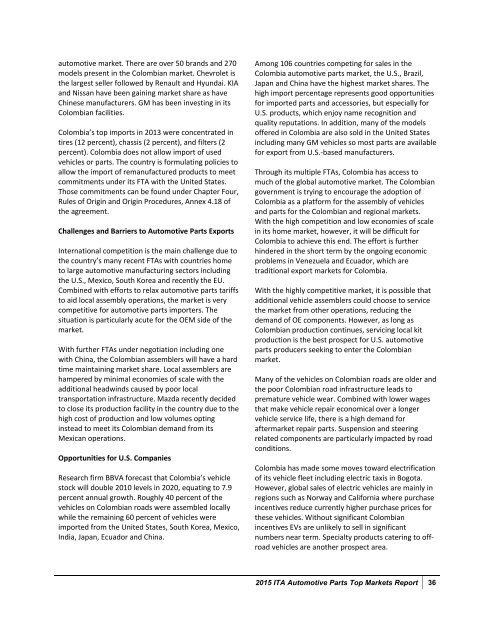Automotive Parts
Autoparts_Top_Markets_Report
Autoparts_Top_Markets_Report
Create successful ePaper yourself
Turn your PDF publications into a flip-book with our unique Google optimized e-Paper software.
automotive market. There are over 50 brands and 270models present in the Colombian market. Chevrolet isthe largest seller followed by Renault and Hyundai. KIAand Nissan have been gaining market share as haveChinese manufacturers. GM has been investing in itsColombian facilities.Colombia’s top imports in 2013 were concentrated intires (12 percent), chassis (2 percent), and filters (2percent). Colombia does not allow import of usedvehicles or parts. The country is formulating policies toallow the import of remanufactured products to meetcommitments under its FTA with the United States.Those commitments can be found under Chapter Four,Rules of Origin and Origin Procedures, Annex 4.18 ofthe agreement.Challenges and Barriers to <strong>Automotive</strong> <strong>Parts</strong> ExportsInternational competition is the main challenge due tothe country’s many recent FTAs with countries hometo large automotive manufacturing sectors includingthe U.S., Mexico, South Korea and recently the EU.Combined with efforts to relax automotive parts tariffsto aid local assembly operations, the market is verycompetitive for automotive parts importers. Thesituation is particularly acute for the OEM side of themarket.With further FTAs under negotiation including onewith China, the Colombian assemblers will have a hardtime maintaining market share. Local assemblers arehampered by minimal economies of scale with theadditional headwinds caused by poor localtransportation infrastructure. Mazda recently decidedto close its production facility in the country due to thehigh cost of production and low volumes optinginstead to meet its Colombian demand from itsMexican operations.Opportunities for U.S. CompaniesResearch firm BBVA forecast that Colombia’s vehiclestock will double 2010 levels in 2020, equating to 7.9percent annual growth. Roughly 40 percent of thevehicles on Colombian roads were assembled locallywhile the remaining 60 percent of vehicles wereimported from the United States, South Korea, Mexico,India, Japan, Ecuador and China.Among 106 countries competing for sales in theColombia automotive parts market, the U.S., Brazil,Japan and China have the highest market shares. Thehigh import percentage represents good opportunitiesfor imported parts and accessories, but especially forU.S. products, which enjoy name recognition andquality reputations. In addition, many of the modelsoffered in Colombia are also sold in the United Statesincluding many GM vehicles so most parts are availablefor export from U.S.-based manufacturers.Through its multiple FTAs, Colombia has access tomuch of the global automotive market. The Colombiangovernment is trying to encourage the adoption ofColombia as a platform for the assembly of vehiclesand parts for the Colombian and regional markets.With the high competition and low economies of scalein its home market, however, it will be difficult forColombia to achieve this end. The effort is furtherhindered in the short term by the ongoing economicproblems in Venezuela and Ecuador, which aretraditional export markets for Colombia.With the highly competitive market, it is possible thatadditional vehicle assemblers could choose to servicethe market from other operations, reducing thedemand of OE components. However, as long asColombian production continues, servicing local kitproduction is the best prospect for U.S. automotiveparts producers seeking to enter the Colombianmarket.Many of the vehicles on Colombian roads are older andthe poor Colombian road infrastructure leads topremature vehicle wear. Combined with lower wagesthat make vehicle repair economical over a longervehicle service life, there is a high demand foraftermarket repair parts. Suspension and steeringrelated components are particularly impacted by roadconditions.Colombia has made some moves toward electrificationof its vehicle fleet including electric taxis in Bogota.However, global sales of electric vehicles are mainly inregions such as Norway and California where purchaseincentives reduce currently higher purchase prices forthese vehicles. Without significant Colombianincentives EVs are unlikely to sell in significantnumbers near term. Specialty products catering to offroadvehicles are another prospect area.2015 ITA <strong>Automotive</strong> <strong>Parts</strong> Top Markets Report 36


